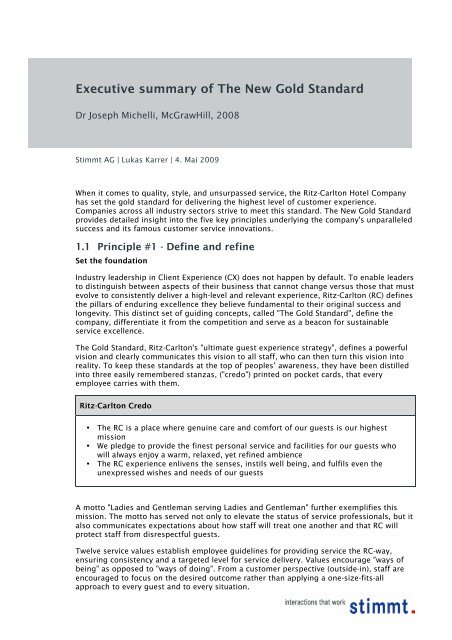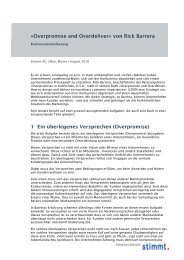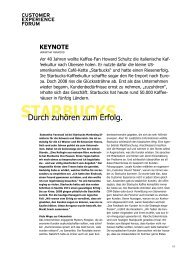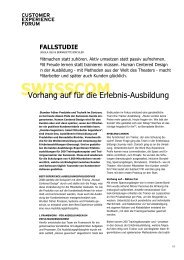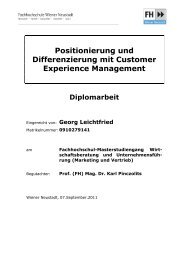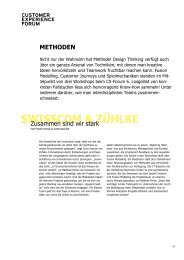Executive summary of The New Gold Standard - Customer ...
Executive summary of The New Gold Standard - Customer ...
Executive summary of The New Gold Standard - Customer ...
Create successful ePaper yourself
Turn your PDF publications into a flip-book with our unique Google optimized e-Paper software.
<strong>Executive</strong> <strong>summary</strong> <strong>of</strong> <strong>The</strong> <strong>New</strong> <strong>Gold</strong> <strong>Standard</strong><br />
Dr Joseph Michelli, McGrawHill, 2008<br />
Stimmt AG | Lukas Karrer | 4. Mai 2009<br />
When it comes to quality, style, and unsurpassed service, the Ritz-Carlton Hotel Company<br />
has set the gold standard for delivering the highest level <strong>of</strong> customer experience.<br />
Companies across all industry sectors strive to meet this standard. <strong>The</strong> <strong>New</strong> <strong>Gold</strong> <strong>Standard</strong><br />
provides detailed insight into the five key principles underlying the company's unparalleled<br />
success and its famous customer service innovations.<br />
1.1 Principle #1 - Define and refine<br />
Set the foundation<br />
Industry leadership in Client Experience (CX) does not happen by default. To enable leaders<br />
to distinguish between aspects <strong>of</strong> their business that cannot change versus those that must<br />
evolve to consistently deliver a high-level and relevant experience, Ritz-Carlton (RC) defines<br />
the pillars <strong>of</strong> enduring excellence they believe fundamental to their original success and<br />
longevity. This distinct set <strong>of</strong> guiding concepts, called "<strong>The</strong> <strong>Gold</strong> <strong>Standard</strong>", define the<br />
company, differentiate it from the competition and serve as a beacon for sustainable<br />
service excellence.<br />
<strong>The</strong> <strong>Gold</strong> <strong>Standard</strong>, Ritz-Carlton's "ultimate guest experience strategy", defines a powerful<br />
vision and clearly communicates this vision to all staff, who can then turn this vision into<br />
reality. To keep these standards at the top <strong>of</strong> peoples’ awareness, they have been distilled<br />
into three easily remembered stanzas, ("credo") printed on pocket cards, that every<br />
employee carries with them.<br />
Ritz-Carlton Credo<br />
• <strong>The</strong> RC is a place where genuine care and comfort <strong>of</strong> our guests is our highest<br />
mission<br />
• We pledge to provide the finest personal service and facilities for our guests who<br />
will always enjoy a warm, relaxed, yet refined ambience<br />
• <strong>The</strong> RC experience enlivens the senses, instils well being, and fulfils even the<br />
unexpressed wishes and needs <strong>of</strong> our guests<br />
A motto "Ladies and Gentleman serving Ladies and Gentleman" further exemplifies this<br />
mission. <strong>The</strong> motto has served not only to elevate the status <strong>of</strong> service pr<strong>of</strong>essionals, but it<br />
also communicates expectations about how staff will treat one another and that RC will<br />
protect staff from disrespectful guests.<br />
Twelve service values establish employee guidelines for providing service the RC-way,<br />
ensuring consistency and a targeted level for service delivery. Values encourage "ways <strong>of</strong><br />
being" as opposed to "ways <strong>of</strong> doing". From a customer perspective (outside-in), staff are<br />
encouraged to focus on the desired outcome rather than applying a one-size-fits-all<br />
approach to every guest and to every situation.
Extract <strong>of</strong> Ritz-Carltons Service Values<br />
• I build strong relationships and create RC guests for life<br />
• I own and immediately resolve guest problems<br />
• I create a work environment <strong>of</strong> teamwork and lateral service so that needs <strong>of</strong> our<br />
guests and each other are met<br />
• I have the opportunity to learn and grow<br />
• I am proud <strong>of</strong> my pr<strong>of</strong>essional appearance, language, and behavior<br />
While most businesses go through the exercise <strong>of</strong> defining values and mission statements,<br />
very few understand the importance <strong>of</strong> regular and repetitive presentation <strong>of</strong> these core<br />
concepts. Beyond the creation and dissemination <strong>of</strong> pocket cards, daily conversations,<br />
conducted in so-called "line-ups", further embrace the gold standards (Repetition <strong>of</strong> values,<br />
common language, oral tradition, positive story telling etc).<br />
Be relevant<br />
As important as it is to establish a framework <strong>of</strong> values to guide an organization's culture,<br />
it is equally crucial to re-evaluate mission statements and ensure they are relevant to the<br />
evolving needs <strong>of</strong> customers. Companies <strong>of</strong>ten cling to their traditional customer segments<br />
without demonstrating the courage to evolve with changing customer trends. Managers’<br />
antennae should be trained to register changing market conditions by studying customer<br />
feedback, sales force intelligence, monitoring word <strong>of</strong> mouth etc.<br />
<strong>The</strong> constant struggle faced by companies attempting to apply the define and refine<br />
principle is knowing when something needs to be defined as an unchangeable brand<br />
standard, and when something can be modified to reflect (local) relevance.<br />
Key take-aways<br />
- Distil mission statement into a set <strong>of</strong> short, memorable, and operational phrases.<br />
- Regularly discuss the mission with staff and incorporate feedback to ensure the<br />
mission is realized.<br />
- If asked, could everyone in the business provide a clear understanding <strong>of</strong> the<br />
company's mission and purpose? <strong>The</strong>se are <strong>of</strong>ten not understood or remembered in<br />
a functional way throughout the organization.<br />
- What are the most basic aspects <strong>of</strong> service you wish to consistently see delivered?<br />
- How simply have you presented the expectations <strong>of</strong> your service standards?<br />
- Daily "line-ups" increase the consistency and frequency <strong>of</strong> messages <strong>of</strong> corporate<br />
mission and values.<br />
- Are you willing to take the time to regularly define the link between operational and<br />
cultural aspects <strong>of</strong> the business?<br />
- What are the visual symbols, oral traditions and positive stories in the business?<br />
- You can never overcommunicate your values!<br />
- All staff should be alerted to the importance <strong>of</strong> customer experience and <strong>of</strong> their<br />
own performance towards delivering it.<br />
- What aspects <strong>of</strong> your service are essential to your brand identity? Which<br />
components can be changed to address diversity <strong>of</strong> customers?<br />
- Do you challenge individuals throughout the company to share ideas that will keep<br />
your business relevant and sustainable?<br />
- No company can be all things to all people, but it is possible to be all things to your<br />
customers.<br />
- Delivering on customers' expressed and unexpressed wishes create clients for life.<br />
Stimmt AG | <strong>Executive</strong> <strong>summary</strong> <strong>of</strong> <strong>The</strong> <strong>New</strong> <strong>Gold</strong> <strong>Standard</strong> 2
1.2 Principle #2 - Empower though trust<br />
Select, don't hire<br />
Because <strong>of</strong> RC's steadfast commitment to and passion for selection, training and<br />
empowerment, staff at RC consistently generate extraordinary customer experiences. In<br />
order for staff to continually and subtly act in ways that not only satisfy but delight<br />
customers, leaders must understand the importance <strong>of</strong> identifying talent and developing<br />
methods to select top candidates. Attracting the best by having an overly generous<br />
compensation plan is the wrong response to the "talent war". RC has addressed this key<br />
issue by espousing a long-standing commitment to assess the strengths <strong>of</strong> a prospective<br />
candidate through a comprehensive process that involves multiple interviews and<br />
identifying the right qualities and requirements for each position. Only individuals who<br />
take pride in providing service are selected. Simply hiring somebody is nothing more than<br />
finding somebody to fill a vacancy.<br />
While many business leaders understand the value <strong>of</strong> a patient, methodological selection<br />
process, they <strong>of</strong>ten take shortcuts and compromise their sound business platforms. In<br />
essence, they succumb to the pressure <strong>of</strong> "we need bodies now". But you cannot microwave<br />
a RC. By choosing the right people in the first place, turnover at RC is about 20% compared<br />
to the industry standard <strong>of</strong> 60%.<br />
Once the costly journey <strong>of</strong> recruitment and selection are completed, many businesses fail<br />
to appreciate the critically important opportunity they are provided during orientation <strong>of</strong><br />
new employees. In many companies, orientation is seen as necessary evil, <strong>of</strong>ten conducted<br />
only to fulfil legal requirements and provide an overview <strong>of</strong> the employee handbook. <strong>The</strong><br />
RC orientation is all about fully understanding and committing to the culture <strong>of</strong> service.<br />
<strong>The</strong>y don't rush you through that. In support <strong>of</strong> grounding new hires deeply and<br />
immediately in mission, vision and values, new staff members cannot start employment<br />
until they have completed the orientation process. Additionally, every employee is certified<br />
in his first 21 days, making sure that they completely aligned with RC’s <strong>Gold</strong> <strong>Standard</strong>s.<br />
While formal training programs are in place, more informal and relationship-based<br />
development opportunities are encouraged. A key stage <strong>of</strong> successfully developing talent<br />
in an organisation is investing time in the mentoring process. To that end, personal growth<br />
and development are not only built into the employee review process but they are also<br />
required <strong>of</strong> the management team.<br />
While it may be a somewhat unique necessity in the hotel industry, lateral service is<br />
strongly encouraged. It is expected that everyone will pitch in to do what is necessary to<br />
get a job done, whether or not it is linked directly to an individual job description. Guests<br />
are not just served better through lateral service. Cross-training naturally occurs,<br />
departments become less isolated form one another and staff members gain a great<br />
empathy for the function <strong>of</strong> those in other areas.<br />
90% <strong>of</strong> staff tend to make the decision to stay or leave within the first 6 months <strong>of</strong><br />
employment. With a firm understanding <strong>of</strong> the speed with which employees can become<br />
disillusioned or disengaged from their work, RC has established "Day 21". On the 21st day<br />
on the job, staff members are given a forum to freely discuss the positives and negatives<br />
they have encountered in their first three weeks. All issues and concerns are collected to<br />
get these addressed. Management then make sure that they get back to the person so that<br />
they know how their issue was resolved. It is important not just to listen, but also to make<br />
sure employees are appraised for the outcome.<br />
Stimmt AG | <strong>Executive</strong> <strong>summary</strong> <strong>of</strong> <strong>The</strong> <strong>New</strong> <strong>Gold</strong> <strong>Standard</strong> 3
It's a matter <strong>of</strong> trust<br />
How does RC stretch human resources and still deliver the consistent, highest-quality<br />
experience for the guests? In one word: trust.<br />
Staff members trust leadership to make staffing decisions that protect employee interests<br />
over the long term. From a financial perspective, this trust is fostered, in part, by<br />
simplifying and creating transparency around certain economic elements in the business.<br />
By making the financial goals clear and understandable, staff in turn are entrusted to<br />
participate in the overall success <strong>of</strong> the business.<br />
Staff are empowered to participate in department-level discussions <strong>of</strong> how they can<br />
individually impact the key success factors - thus building greater staff involvement in the<br />
business by drawing a clear line-<strong>of</strong>-sight connection between each employee and the<br />
overall success <strong>of</strong> the company.<br />
RC developed an Employee Promise to communicate to employees what they can count on<br />
from their employer. <strong>The</strong> Employee Promise identifies all the different processes that are in<br />
place to serve as a commitment to staff, from career planning to empowerment<br />
philosophy. At the core <strong>of</strong> the employee promise is a stated commitment to nurture talent<br />
for the mutual benefit <strong>of</strong> the individual and the company.<br />
RC systematically analyzes the trust and engagement <strong>of</strong> their employees through formal<br />
surveys conducted by third parties.<br />
In work environments characterized by distrust, it is common for frontline workers to say "I<br />
will have to get my manager’s approval on this." <strong>The</strong> RC culture emphasizes service values<br />
such as "I am empowered to create unique, memorable and personal experiences for our<br />
guests" or "I own and immediately resolve guests problems". To further punctuate the<br />
autonomy and trust in staff, leadership has created a vehicle that clearly permits staff to<br />
use their own discretion in service delivery or service recovery. <strong>The</strong> approach involves<br />
giving each employee the ability to exercise judgement in spending up to $2000 per guest<br />
per day, if needed, either to enhance the guest experience or to afford immediate problem<br />
resolution. <strong>The</strong> advantage <strong>of</strong> the $2000 staff empowerment guideline is that employees<br />
don't have to delay service response by taking it up to the next level. <strong>The</strong>y can take<br />
initiative without seeking permission to enhance guest experiences.<br />
Ultimately, by <strong>of</strong>fering trust, the company will reap significant financial benefits and<br />
increased customer loyalty.<br />
Key take-aways<br />
- Beyond technical skills, what processes do you have in place to study the<br />
commitment and strengths <strong>of</strong> your prospective employees?<br />
- How <strong>of</strong>ten does expediency take priority over careful selection?<br />
- A dedication to hiring the best service pr<strong>of</strong>essionals, no matter how long it takes,<br />
helps RC to obtain and maintain top performers.<br />
- How effectively do you acclimatize leaders into your organisation?<br />
- What listening process do you have in place to re-engage new hires early in their<br />
employment tenure?<br />
- Leaders who focus detailed attention on the wants and needs <strong>of</strong> their staff<br />
ultimately see that the same detailed, personalized attention is being passed on to<br />
customers.<br />
- Lateral service strengthens the organisation and breaks down silos. When<br />
leadership works side by side with staff, a "we are all in this together" message is<br />
clearly received.<br />
- Have you defined a short list <strong>of</strong> annual key success factors for your business, to<br />
help staff trust that you will demonstrate consistency in the initiatives you pursue?<br />
- Do you communicate the salient drivers <strong>of</strong> success to your frontline employees and<br />
solicit their input on how they can affect these factors?<br />
- How does leadership take a genuine interest in the lives and ideas <strong>of</strong> all employees?<br />
Stimmt AG | <strong>Executive</strong> <strong>summary</strong> <strong>of</strong> <strong>The</strong> <strong>New</strong> <strong>Gold</strong> <strong>Standard</strong> 4
- What can you do to help employees automatically respond to the needs <strong>of</strong><br />
customers without seeking higher level approval?<br />
- Set l<strong>of</strong>ty objectives for your staff members, and then, empower staff to reach them.<br />
- When leaders listen and respond to the needs <strong>of</strong> their staff, they encourage<br />
behaviors that fuel mutual respect companywide.<br />
- Entrusting frontline workers with financial responsibility propels them to make<br />
savvy decisions and establishes an environment <strong>of</strong> greatness, whereas negativity<br />
and distrust shrink morale and service impact.<br />
- Trusting employees to make financial decisions doesn't necessarily translate to a<br />
significant capital investment. On the contrary, when problems are solved quickly<br />
instead <strong>of</strong> being allowed to fester into bigger issues, it can mean savings and client<br />
retention.<br />
- Empowering through trust instils a sense <strong>of</strong> pride in employees, leading to service<br />
excellence at every level <strong>of</strong> a company.<br />
- Removing barriers that interfere with an employee's work performance can mean<br />
the difference between an employee simply doing his job, and an employee doing<br />
his job and enjoying it.<br />
1.3 Principle #3 - It's not about you<br />
Build a business focused on others<br />
Rather than taking a top-down approach to quality, in which leaders create processes and<br />
impose them on staff, RC has built their processes largely through inquiry. Corporate<br />
leaders pay attention to the voice <strong>of</strong> their customers, the wisdom <strong>of</strong> world-class<br />
businesses, the ideas and feelings <strong>of</strong> staff, and the wishes <strong>of</strong> the hotel owners. Wideranging<br />
and rigorous listening programs help them avoid building the business from the<br />
"inside-out".<br />
To assess the engagement <strong>of</strong> RC staff, Gallup's Employee Engagement Metric is used:<br />
Gallup's Employee Engagement Metric<br />
• I know what is expected <strong>of</strong> me at work.<br />
• I have materials and equipment to do my job right<br />
• At work, I have the opportunity to do what I do best every day<br />
• In the last seven days, I have received recognition or praise for doing good<br />
work.My supervisor, or someone at work, seems to care about me as person<br />
• At work, my opinions seem to count<br />
• <strong>The</strong> mission/purpose <strong>of</strong> my company makes me feel my job is important.<br />
• My co-workers are committed to doing quality work<br />
• I have a best friend at work<br />
• In the last six months, someone has talked to me about my progress<br />
• This last year, I have had opportunities at work to learn and grow. strong<br />
relationships and create RC guests for life<br />
• I own and immediately resolve guest problems<br />
• I create a work environment <strong>of</strong> teamwork and lateral service so that needs <strong>of</strong> our<br />
guests and each other are met<br />
• I have the opportunity to learn and grow<br />
• I am proud <strong>of</strong> my pr<strong>of</strong>essional appearance, language, and behavior<br />
In contrast to measuring customer satisfaction (a measure <strong>of</strong> the thoughts a customer has<br />
towards the business <strong>of</strong>fering), RC measures customer engagement (a better metric <strong>of</strong> the<br />
emotional connection and perceived fit held by a customer towards a business, and overall<br />
customer loyalty). A solid correlation has been established between the guest engagement<br />
score and important financial outcomes.<br />
Stimmt AG | <strong>Executive</strong> <strong>summary</strong> <strong>of</strong> <strong>The</strong> <strong>New</strong> <strong>Gold</strong> <strong>Standard</strong> 5
Gallup's <strong>Customer</strong> Engagement Metric<br />
• How satisfied are you with RC?<br />
• How likely are you to continue to chose RC?<br />
• How likely are you to recommend RC to a friend?<br />
• RC is a name I can always trust.<br />
• RC always delivers on what they promise.<br />
• RC always treats me fairly.<br />
• If a problem arises, I can always count on RC to reach a fair and satisfactory<br />
resolution.<br />
• I feel proud to be a RC customer.<br />
• RC always treats me with respect.<br />
• RC is the perfect hotel for people like me.<br />
• I can't imagine a world without RC.<br />
RC made the bold decision to clearly designate their hotels as either red, yellow, or green<br />
performers. In so doing, they manage against the expectations <strong>of</strong> the customer’s needs<br />
and not arbitrary goals. Designating a hotel as "red" was a tremendous motivation for staff<br />
to find ways to drive guest engagement.<br />
In addition to listening to and measuring the input <strong>of</strong> staff, guests, and desired future<br />
customers, RC leadership creates forums to secure the input <strong>of</strong> their key referral sources in<br />
the travel industry.<br />
Support frontline empathy<br />
Anticipating the customer's unstated needs is the goal <strong>of</strong> every employee, and each<br />
fulfilment <strong>of</strong> a need should be as individual as the customer. <strong>The</strong> intimacy <strong>of</strong> interpersonal<br />
caring and the art <strong>of</strong> anticipation are critical aspects <strong>of</strong> RC service culture. In fact, they are<br />
the secret ingredient <strong>of</strong> the RC mystique.<br />
In order to create a memorable experience, a service provider has to connect with a guest's<br />
individuality and deliver service customized to that guest's preferences. To produce<br />
memorable experiences, leadership must help staff to both inquire and execute on the<br />
details <strong>of</strong> historical information gathered about the customer. One <strong>of</strong> the greatest risks<br />
however, to asking guests their preferences is that it sets up an expectation that those<br />
preferences will be acted upon. That is why RC likes to pick up as much as they can about a<br />
guest from direct observation and not to draw too much attention to those moments when<br />
specifically seeking out preferences. One <strong>of</strong> the keys to great service is to find a way not to<br />
be intrusive, but rather to be observant.<br />
Research shows that if you handle a problem quickly and adequately, you might get a more<br />
loyal guest than if there were no problems at all. It all comes down to taking the focus <strong>of</strong>f<br />
your needs and stepping into the shoes <strong>of</strong> the guest. If you see a problem, you own it. Your<br />
title is irrelevant.<br />
Key take-aways<br />
- What outside business experts do you invite into your company to evaluate the gaps<br />
in the quality <strong>of</strong> your services?<br />
- Whose processes do you study (peers, industry leader etc.)?<br />
- Do you measure the emotional engagement <strong>of</strong> your employees?<br />
- How are you measuring your company's ability to foster an ownership position<br />
among your employees? Are you assessing the degree to which employees have the<br />
materials and resources they need to do the job?<br />
- What efforts do you make to not only measure the satisfaction <strong>of</strong> your customers,<br />
but also their emotional engagement with your brand?<br />
Stimmt AG | <strong>Executive</strong> <strong>summary</strong> <strong>of</strong> <strong>The</strong> <strong>New</strong> <strong>Gold</strong> <strong>Standard</strong> 6
- Do all employees at all levels <strong>of</strong> your organisation understand your customer<br />
feedback metrics? Do they understand the importance <strong>of</strong> those metrics to the<br />
overall success <strong>of</strong> the business?<br />
- How do you attempt to listen to the needs and opinions <strong>of</strong> those who choose other<br />
providers?<br />
- Would your company be described as a customer-centric business or a more inwardlooking<br />
business focused on process efficiencies?<br />
- Great leaders take the time to ask; they repeatedly inquire, listen, and then act.<br />
- An engaged workforce personally invests in success and business growth, while<br />
creating an engaged clientele.<br />
- Encourage your employees to be involved in the planning <strong>of</strong> the work and processes<br />
that affect them.<br />
- Have you helped staff understand the distinction betweens anticipating and<br />
fulfilling customer needs?<br />
- What processes do you have in place to track customer preferences? Is that data<br />
used to personalize customer service?<br />
- How safe is it for staff to share operational problems and mistakes, without the fear<br />
<strong>of</strong> reprisal?<br />
- What processes do you have in place to track breakdowns and defects?<br />
- How effectively does leadership collect, compile, and communicate quality<br />
performance data?<br />
- How do you balance your company's need to track customers preferences with the<br />
customer's need for privacy?<br />
- <strong>Customer</strong> engagement is measurable.<br />
- Extraordinary service providers connect with each customer's individuality and<br />
deliver service that is customized to every person's preferences.<br />
- Personalizing service means paying attention to subtlety and nuance in client<br />
behaviours and committing to deliver on these client inclinations.<br />
- Asking questions and showing concern for your customers is valuable only if you<br />
act on those needs.<br />
- Collect and track client-interaction data to constantly build on successes and repair<br />
breakdowns.<br />
1.4 Principle #4. Deliver wow!<br />
Research has shown that customers who are merely "satisfied" with a company's service are<br />
far less likely to remain loyal to that business than customers who are "extremely<br />
satisfied". Specifically, customers who reported they were "extremely satisfied" with a<br />
business were 2.5 times more likely than only "satisfied" customers to make future<br />
purchases. Extremely satisfied customers emerge through memorable and emotional<br />
connections forged between them and a business.<br />
Apparently, we've moved beyond the era <strong>of</strong> "delighting" customers and are now in an era<br />
where much more is expected. RC leadership calls this desired memorable and emotional<br />
connection a "Wow experience". <strong>The</strong> importance <strong>of</strong> delivering a Wow moment at a guest’s<br />
first point <strong>of</strong> contact is, therefore, a primary goal.<br />
Many examples are given:<br />
• Couple, wife pregnant, celebrating their first anniversary in RC -> Bottle <strong>of</strong> sparkling<br />
cider instead <strong>of</strong> champagne in Hotel room; special body pillow in room.<br />
• Sick guest "disturbed" by room cleaning -> Concierge calls later to check how she is<br />
feeling and if she needs a doctor.<br />
• Business-Guest reserved 4 weeks stay -> RC printed business cards with in-room<br />
telephone, fax number to hand out.<br />
• Guest goes jogging -> staff receives him with a warm towel and bottle <strong>of</strong> water<br />
Stimmt AG | <strong>Executive</strong> <strong>summary</strong> <strong>of</strong> <strong>The</strong> <strong>New</strong> <strong>Gold</strong> <strong>Standard</strong> 7
Some <strong>of</strong> the greatest opportunities for wowing customers occur when breakdowns happen.<br />
<strong>The</strong> steps involved in salvaging a bad experience (whether caused by your business or not)<br />
are fairly simple, yet all too <strong>of</strong>ten these steps are not followed:<br />
1. share a genuine and compassionate reaction to the person's distress<br />
2. <strong>of</strong>fer appropriate apologies<br />
3. assure the client that you will take care <strong>of</strong> the issue<br />
4. see that the problem is taken care <strong>of</strong> in a way that meets the satisfaction <strong>of</strong> the<br />
client and does not recur<br />
5. go one step further to demonstrate that you want to try to compensate for the<br />
person's loss or frustration<br />
Bad news lingers. In a world where customer opinions remain on the Internet and where<br />
people are more likely to share negative experiences than positive ones, the lasting impact<br />
<strong>of</strong> delayed service recovery can negatively affect prospective customers.<br />
With the ease <strong>of</strong> worldwide communication, companies can't just practice service recovery<br />
but must instead execute immediate service recovery. <strong>The</strong> sooner customers are satisfied,<br />
the less likely they are to share a negative review that may have damaging consequences.<br />
Turn wow into action<br />
Wow stories are one <strong>of</strong> the most important vehicles that the leadership at RC uses for<br />
communicating the values they see as critical for the success <strong>of</strong> the company. If an<br />
employee's action results in a wow story, this is published internally and the employee gets<br />
rewarded with $100. While this financial acknowledgement is valued, it's more about the<br />
recognition and just having done a great job. Staff take pride in what they do. It's about the<br />
joy in being able to serve. In addition, keeping track <strong>of</strong> wow stories helps RC provide<br />
examples <strong>of</strong> customer service excellence that match important corporate themes and<br />
business targets for the year. RC also sets objectives on how many stories each hotel will<br />
submit each year, holding leadership responsible for constantly identifying people that are<br />
doing things well.<br />
Wow stories are but one tool for communicating with staff. Ultimately, this tool has to be<br />
understood in the context <strong>of</strong> the objectives it achieves. Namely, helping leadership identify<br />
and communicate desired guest outcomes. In order for wow stories to be maximally<br />
successful, they can't stand alone. <strong>The</strong>y must be supported by open communication from<br />
leadership to staff and staff to leadership. <strong>The</strong>y must be part <strong>of</strong> a constant dialogue about<br />
service, quality, values and excellence. <br />
Key take-aways<br />
- In what ways have you designed service delivery that appeals to both thinking and<br />
feeling aspects <strong>of</strong> the consumer?<br />
- How do staff gain an awareness <strong>of</strong> the opportunities they have to wow or make<br />
emotional connections with customers at every touch point <strong>of</strong> the cutomer<br />
interaction?<br />
- Can staff distinguish between the purpose and function <strong>of</strong> their job<br />
- How readily do you and your staff wow customers through immediate service<br />
recovery?<br />
- While it is easy to deliver, a warm welcome is rare enough to stand out in the minds<br />
<strong>of</strong> customers.<br />
- <strong>The</strong> more quickly a problem is resolved, the more quickly it is forgotten.<br />
- Whether or not a business is responsible for issues and mistakes, a customer is<br />
most likely to remember who took the initiative to fix them.<br />
- What methods do you have in place to capture positive stories <strong>of</strong> service excellence<br />
or other highly valued employee behaviors?<br />
- What forum do you have in place to which routinely share these stories?<br />
- Do you tell stories that reinforce core cultural values and paint a compelling picture<br />
<strong>of</strong> your goals?<br />
Stimmt AG | <strong>Executive</strong> <strong>summary</strong> <strong>of</strong> <strong>The</strong> <strong>New</strong> <strong>Gold</strong> <strong>Standard</strong> 8
- Have you created an environment in which all employees can exchange positive<br />
service stories?<br />
- How do you capture and share stories <strong>of</strong> collaboration and great teamwork?<br />
- Wow moments happen in every workplace. Collect and share those stories with all<br />
employees to generate an environment <strong>of</strong> top performance.<br />
- Annual awards presentations are valuable, but regular, frequent recognition is<br />
necessary to sustain a culture <strong>of</strong> excellence.<br />
- Reward excellence by publicly acknowledging the person who acted above and<br />
beyond the call <strong>of</strong> duty so as to motivate others to emulate those behaviors.<br />
- Look for ways to identify employees that do something well.<br />
- Help your employees to understand how much interpersonal power they have,<br />
individually and collectively, to positively affect the lives <strong>of</strong> their customers and the<br />
overall success <strong>of</strong> the business.<br />
- Providing excellent service is a reward unto itself.<br />
1.5 Principle #5 - Leaving a lasting footprint<br />
In the competitive world <strong>of</strong> business today, leaders are looking for opportunities to<br />
maintain the relevance and sustainability <strong>of</strong> their established brands. Based on customers'<br />
perceptions and knowledge <strong>of</strong> your brand, there are certain types <strong>of</strong> products that<br />
customers would expect you to sell. For many, RC was such an important part <strong>of</strong> their lives<br />
that they eagerly wanted to reconnect with the company whenever possible.<br />
Examples <strong>of</strong> RC Brand Extensions<br />
• RC-club - exclusive, luxury-tier, deeded fractional ownership real estate<br />
• RC-spa and golf-club<br />
• RC-residences, privately owned properties overseen and managed by RC staff<br />
While brand consultants talk about the "elasticity" <strong>of</strong> a brand (how far can a company<br />
stretch its diversity <strong>of</strong> <strong>of</strong>ferings before customers reject the products), leadership at RC is<br />
more focused on how brand extensions can strengthen one another. In essence, they view<br />
each <strong>of</strong>fering as an opportunity to strengthen the connections between their products.<br />
Key take-aways<br />
- When considering new products or expansion opportunities for your brand, have<br />
you explored the perceptions <strong>of</strong> your customer base?<br />
- What service <strong>of</strong>ferings would stretch the elasticity <strong>of</strong> your brand?<br />
- How can you best position your products or services to strengthen your overall<br />
brand, while driving your customers from one business <strong>of</strong>fering to the next?<br />
- Truly engaged clients are especially keen to experience expanded product and<br />
service lines from the businesses they trust and respect.<br />
- Great brand extensions emerge from the core competencies <strong>of</strong> a company.<br />
- Businesses too focused on the bottom line will create a legacy only for their<br />
investors.<br />
- Have you clearly defined a systematic approach to corporate social responsibility<br />
with specified themes for giving?<br />
- How far is your company willing to go in support <strong>of</strong> corporate volunteerism and<br />
social involvement?<br />
- What return values does your staff receive from their social responsibility efforts?<br />
- Community engagement efforts by businesses might not provide measurable<br />
dividends to investors, but great leaders consider this engagement as a long-term<br />
benefit for their people and an essential ingredient to creating sustainable<br />
relationships in areas where they do business.<br />
Stimmt AG | <strong>Executive</strong> <strong>summary</strong> <strong>of</strong> <strong>The</strong> <strong>New</strong> <strong>Gold</strong> <strong>Standard</strong> 9


